Did you know that 80% of social media buyers strive to boost engagement, yet only 50% have witnessed increased sales?
As the vital link between businesses and their target audience, digital media buyers play a crucial role in maximizing the potential of social media. However, the ever-changing nature of the digital landscape presents significant challenges.
Cracking The Code To Successful Social Media Buyer Strategies
To navigate this dynamic field successfully, social media buyers must overcome the challenges and pain points that often arise. These include managing limited budgets, combating ad fatigue, and measuring campaign effectiveness.
Nonetheless, highly successful social media buyers have discovered secret techniques and approaches that set them apart.
- Precision in Audience Targeting
- Understanding Contextual Targeting and its Relevance to Your Campaigns
- Monitoring, Analyzing, and Enhancing Campaign Performance
- Staying Ahead of Trends and Industry Updates
- Utilizing Essential Tools for Your Social Media Strategy
Precision in Audience Targeting
Understanding the target market lets social media buyers tailor messages and optimize ad placements, boosting conversion rates. Several methods are available for audience targeting, such as demographic, geographic, behavioral, and more. Combining these strategies enables social media buyers to reach their brand or product’s most relevant target audience.
Let’s explore some of these key targeting methods:
Demographic Targeting
It’s not just simply age and gender anymore. Platforms like Facebook and LinkedIn offer various options, including relationship status, education level, and life events.
By cracking the code and experimenting with different demographic targeting options, digital media buyers can discover the most effective choices for marketing campaigns.
Geographic Targeting
Enhance your targeting precision by narrowing your focus to specific cities, states, or zip codes. This localized approach allows you to direct your ads toward the areas where your target audience resides or your physical stores.
To maximize the impact of brick-and-mortar establishments, digital media buyers should consider utilizing radius targeting. This enables you to reach potential customers within a designated distance from the physical locations.
Related article: A Guide To DMA Geo-targeting On Tiktok
Platform Targeting
To maximize the effectiveness of your ad delivery, it’s essential to understand the demographic preferences of different platforms. For example, Instagram attracts a younger audience, while YouTube appeals to all age groups. The chart below provides a visual representation of the breakdown of social media use by age group and platform in the US:
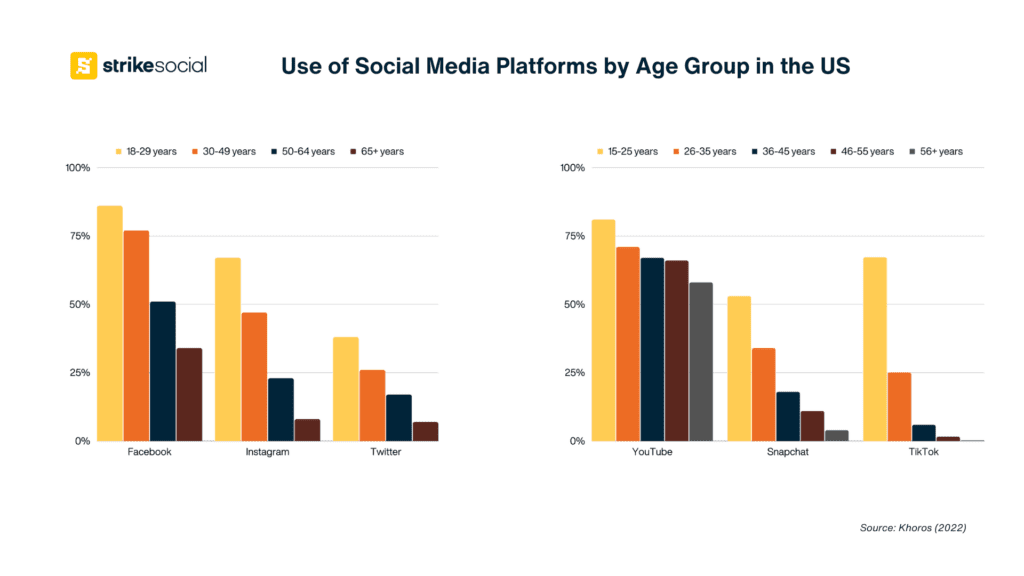
Interest Targeting
With interest targeting, social media buyers can connect with users who have already expressed interest in your product or content. This allows you to tailor your ads to those more likely to engage and convert.
TikTok’s ad targeting algorithm analyzes users’ long-term interests and consistent platform activities to provide a deeper understanding of their preferences. Explore the TikTok Interest targeting list below to represent available options visually.
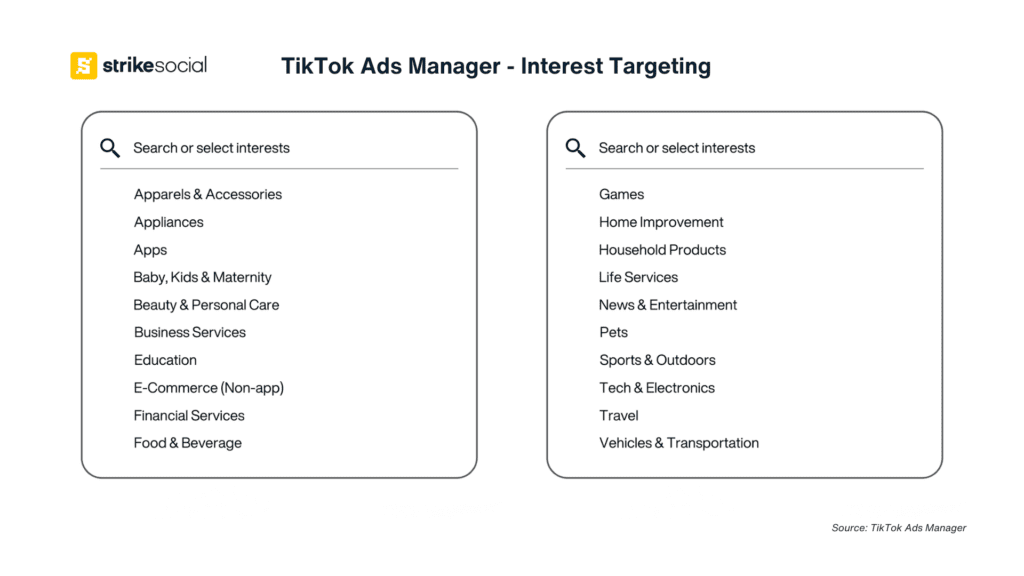
Keyword Targeting
By carefully selecting relevant keywords, you can showcase your ads within search results or on websites that align with those keywords. This enables social media buyers to connect with the target audience seamlessly and without disruption, as they are already engaged with related content. For example, if you’re promoting a fitness app, you can target keywords like “workout routines” or “healthy lifestyle” to display your ads to users actively searching for or reading about fitness-related topics.
Tip: Remember to exclude negative keywords or topics to prevent your brand from being associated with negative or unrelated content.
More ad targeting strategies
To maximize reach and engagement, digital media buyers need to implement a comprehensive array of targeting strategies that resonate with the unique preferences and behaviors of the target audience.
Here are some additional targeting tips to consider:
- Set up a lookalike audience: Take advantage of Facebook’s capability to create lookalike audiences based on existing customer databases from previous campaigns or external lead forms. This powerful feature allows social media buyers to expand their reach by targeting audiences with similar characteristics and behaviors to the existing customer base.
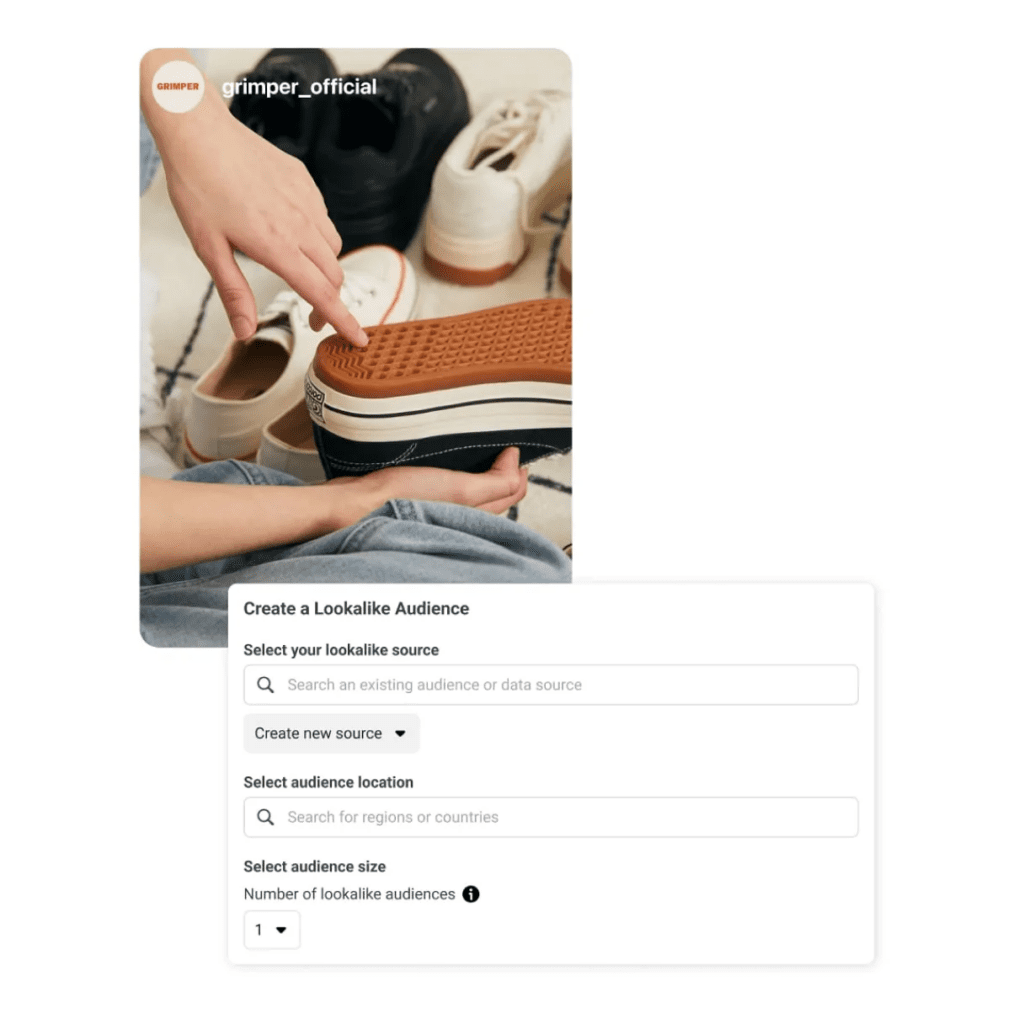
Source: Facebook
- Avoid overly specific targeting: While refining your audience targeting is important, be cautious not to narrow it down excessively. Keep an eye on your campaign’s reach and ensure your targeting remains broad enough to maintain a viable audience.
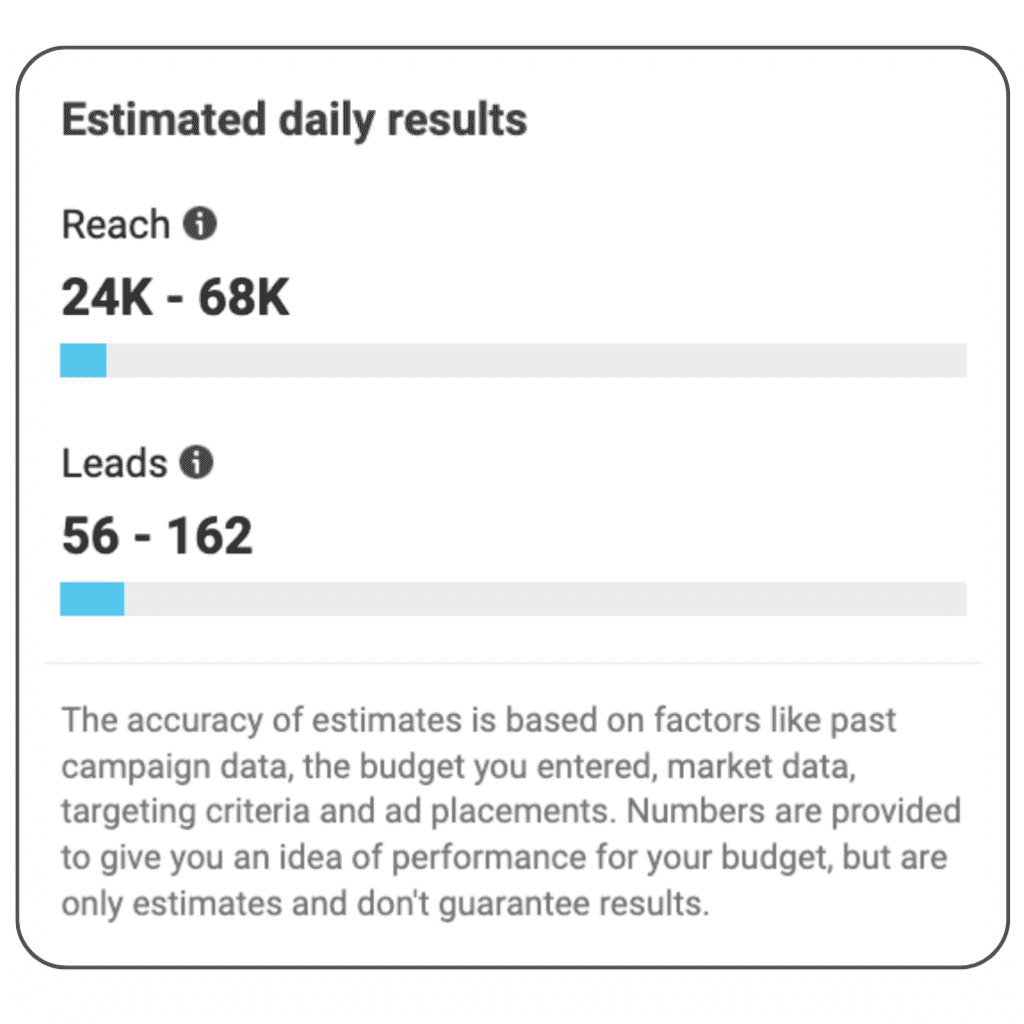
- Experiment with different ad formats: Explore a variety of ad types like image ads, video ads, carousel ads, or stories. Test and optimize to find the best-paid ad formats that resonate best with your target audience.
Related article: Improve your targeting with Facebook Audience Insights
Understanding Contextual Targeting and its Relevance to Your Campaigns
Contextual targeting refers to placing ads on web pages based on the content of those pages. This is done through contextual targeting on an ad network, which involves segmenting ads based on parameters like keywords or website topics.
Here’s an example from YouTube. When looking up “content marketing,” an ad for video creation assets appears before the top search results:
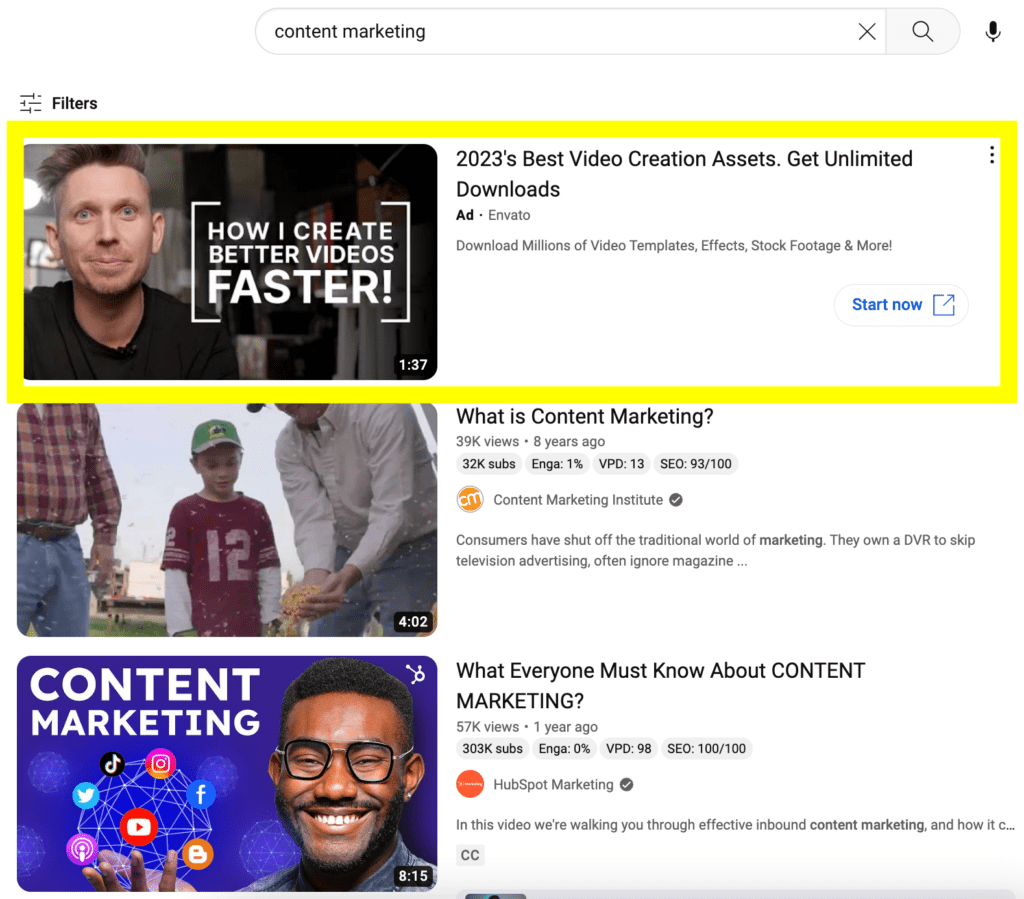
Considering the removal of third-party cookies, the relevance of contextual targeting becomes even more significant. With increasing privacy concerns and changing regulations, the ability to track user behavior and preferences through cookies is diminishing.
Contextual ad targeting offers an alternative approach that respects user privacy while delivering personalized and relevant ads. By focusing on the content and context of web pages, social media buyers can continue to reach their desired target audience effectively without relying heavily on user-specific data.
How do you use contextual targeting?
Here are some key steps for social media buyers to effectively utilize contextual ad targeting:
- Choose relevant platforms: Select social media marketing platforms that align with your product or service and are frequented by your target audience. For example, social media sites like Instagram and TikTok are known for their visual appeal. By channeling efforts on platforms where the audience actively engages, digital media buyers can increase the chances of reaching the right people.
- Craft engaging and relevant ad content: To maximize the impact of your contextual targeting efforts, create content that resonates with the specific page’s content. This includes both the visual creatives and the copy within those creatives.
Ensure that your ad’s visuals, whether static images, interactive ads, or GIFs, are appealing and captivating. Similarly, the copy should be tailored to the context and deliver a clear and compelling message. Craft concise and attention-grabbing captions that complement your visuals. - Use hashtags: You can promote your products or services, increasing visibility among potential customers. Digital media buyers can leverage hashtags to raise awareness about a cause, initiate conversations, or stay updated on trending topics and breaking news.
The ultimate goal of contextual targeting is to ensure that your ads are seen by the most relevant audience, creating a seamless connection between their interests and the products or services you offer.
Monitoring, Analyzing, and Enhancing Campaign Performance
Digital ad spending has witnessed an 8% increase from 2022 to 2023, indicating a growing shift toward online marketing. This transition is driven by the advantages of digital advertising, such as the ability to track performance and measure the impact of specific digital assets.
As digital marketing ad spend increases, determining effectiveness and return on investment becomes crucial.
The key lies in monitoring, analyzing, and enhancing ads performance to ensure optimal results.
Understanding and Analyzing Campaign Performance
Identify the key performance indicators (KPIs) that align with the marketing objectives. By focusing on one or two relevant metrics, digital media buyers can concentrate on reaching optimum performance for your selected campaign KPI. This targeted approach ensures a clearer understanding of the effectiveness of the ad campaigns and enables data-driven decision-making.
When it comes to tracking metrics for different ad campaign goals, here are some examples that digital media buyers should consider:
| Campaign Goal | Metrics to Track |
| Sales | Cost-per-acquistion (CPA) Ad spend Return on ad spend (ROAS) |
| Engagement | Clicks Click-through rate (CTR) Post engagement |
| Lead generation | Conversion rate Cost-per-lead (CPL) Click-through rate (CTR) |
Source: People.ai, AgencyAnalytics
By ensuring that each metric contributes to the broader marketing objectives and aligns with the overall success of your campaigns, you can maintain a focused approach and make informed decisions based on the bigger picture.
Achieving Optimal Performance through Regular Monitoring
Consistently reviewing and analyzing campaign performance empowers social media buyers to identify patterns, uncover areas for improvement, and capitalize on opportunities. Unlike the traditional approach of setting up campaigns and leaving them to run, regular monitoring enables real-time adjustments and optimization based on performance metrics.
A strategic approach is necessary to enhance the performance of your digital marketing campaigns. Consider the following key steps:
- Allocate resources to high-performing placements and optimize ad content accordingly. By investing more in the placements that yield positive results, you can amplify the impact of your campaigns. Simultaneously, if certain placements underperform, adjusting targeting parameters or exploring alternative options can enhance your campaign’s effectiveness.
- Regularly review and refine your ad content, including headlines, visuals, and messaging. Analyze which elements resonate most with your target audience and make data-driven adjustments to enhance engagement and conversion rates.
- Continuously optimize your targeting strategy. Refine your audience targeting based on campaign performance data and leverage targeting options and platforms with the greatest potential for reaching your desired audience.
Staying Ahead of Social Media Buyer Trends and Industry Updates
By keeping a pulse on emerging trends, social media buyers can adapt strategies, seize opportunities, and stay one step ahead.
But how do you identify these social media advertising trends?
TikTok Creator Marketplace and Instagram Creator Marketplace are valuable platforms to discover emerging trends and connect with content creators at the forefront of innovation. These marketplaces enable digital media buyers to tap into the creativity and insights of influential voices, helping you stay informed and leverage the latest trends.
Let’s take a closer look at some specific trends that are shaping the social media landscape:
- Influencer marketing: Collaborating with influential individuals with a dedicated following allows brands to tap into their credibility and reach a wider audience, driving brand awareness and fostering trust.
- Short-form video content: According to Hubspot, 83% of marketers using short-form videos say it’s their most effective content format. These videos’ dynamic and immersive nature fosters greater viewer engagement, resulting in higher click-through rates and improved campaign performance.
- Live video content: This interactive medium fosters genuine interactions, drives meaningful conversations, and strengthens brand-consumer relationships.
- Hashtags: By including relevant hashtags in your posts, you join conversations on social media marketing platforms and increase your post’s visibility within those discussions. Creating a branded hashtag can be a powerful tool to promote your business, drive conversations, and enhance brand recognition.
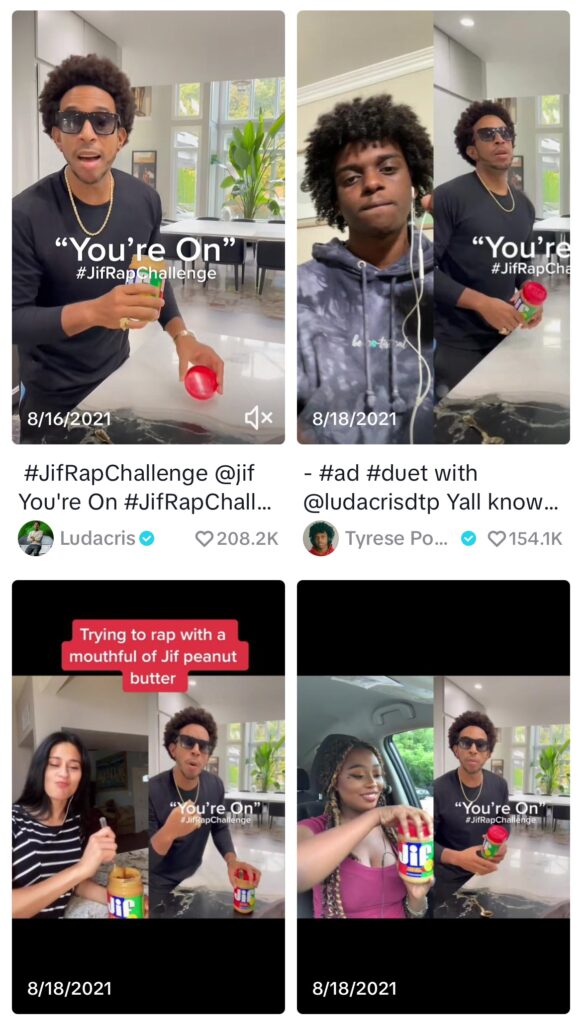
Source: TikTok
A prime example of this is the #JIFRapChallenge launched by JIF Peanut Butter on TikTok, featuring rapper Ludacris rapping with a mouth full of peanut butter. This creative challenge generated over 200,000 impressions and spurred the creation of 600 unique videos, showcasing the potential impact of well-executed hashtag campaigns.
Utilizing Essential Tools for Your Social Media Strategy
In a recent campaign, we discovered the significant impact of focusing on YouTube Shorts for achieving campaign efficacy. Although our initial goal was to generate engagements, we quickly recognized the influential power of short-form videos and their ability to drive high views at favorable ad costs. By leveraging the popularity and engagement of YouTube Shorts, we optimized our campaign and achieved exceptional results.
Through a carefully designed strategy backed by data-driven insights, our campaign surpassed all expectations and delivered outstanding results. We achieved a remarkable 44% improvement in CPV efficiency, surpassing benchmarks. Moreover, the campaign went above and beyond by delivering a Cost Per Click for creatives utilizing short-form content. Video ads that appeared in YouTube Shorts are 8.5% more efficient than the overall CPC.
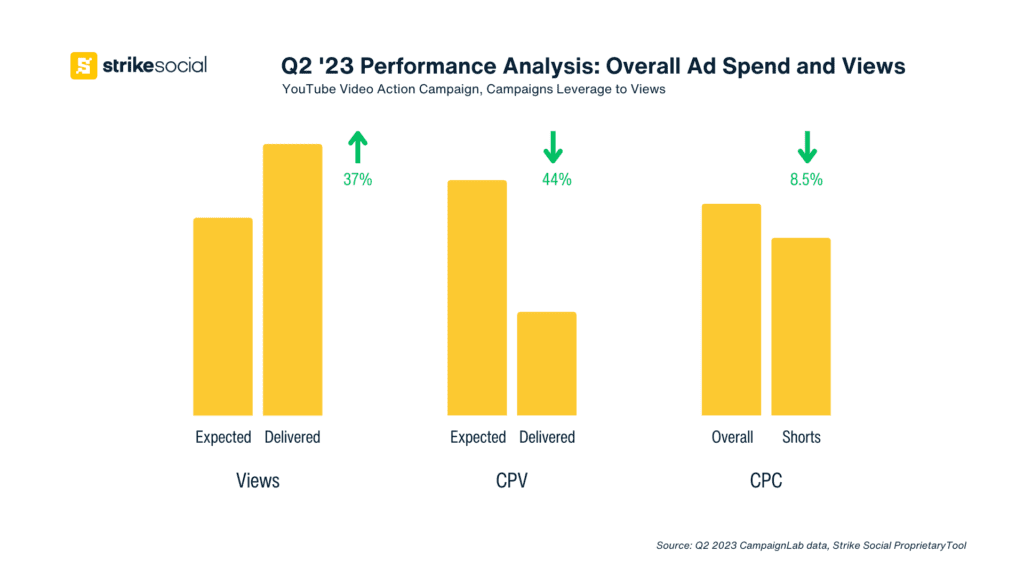
We successfully engaged our target audience, captured their attention, and surpassed our desired metrics through careful planning, content optimization, and leveraging our social media marketing tools.
How Social Media Buyers Shape Marketing Success
Social media buyers hold the key to unlocking the full potential of digital marketing campaigns. By implementing the strategies and insights discussed above, you can confidently navigate the ever-evolving social media landscape and achieve exceptional results.
The key to a successful social media buyer strategy lies in understanding your target audience, optimizing campaign performance, staying up-to-date with trends, and leveraging the right tools. So, equip yourself with these insights, stay informed, and harness the power of these 5 secrets to achieve your marketing goals.








